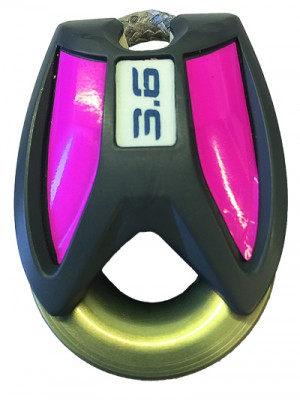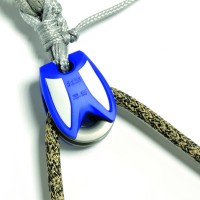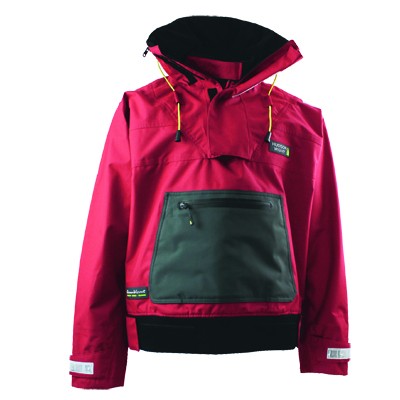Pip Hare raced the Class 40 Concise 2 in the two-handed Transat Jacques Vabres race from France to Brazil in October. We asked her to rate some of the gear she used on the 5,400nm crossing
Varta High Optics 3C Flashlight – 9/10
Used: every night of the race for sail trim, sail changes, rig checks and problem solving.

This handheld torch allowed me to pick out a masthead halyard at its exit point 16m above the deck on the blackest and wettest of nights, making it one of my most reached-for pieces of kit for this race. A great bit of Atlantic gear.
At 450g with batteries and measuring 259mm in length, this is not a small item and won’t fit in an inside pocket, so we tended to keep this torch in a halyard bag next to the steering position and then transferred it to a pocket or hung it around our neck on a lanyard for use on the foredeck.
The torch offers 300 lumens of light from a 4W LED light source, which can be set as a floodlight or focused to a very tight spotlight able to pick out the top telltale on the back of the mainsail. The power output and floodlight ability of the torch mean it will also be accepted by race authorities as a high-powered rescue spotlight.
The High Optics has a water-resistant IPX4 rating, which means it can cope with ‘splashing’; however we sailed the whole race with our torch living outside. It was regularly soaked by incoming waves across the deck, with no sign of water damage or ingress. Over
a 28-day period we changed the batteries once, and I certainly used the torch every night for checking sail trim.
The lanyard attachment point could be stronger – we broke ours off after a couple of weeks – but I would definitely recommend keeping one of these torches in the cockpit within arm’s reach on all overnight passages.
Price £39.99. www.en.varta-consumer.com
Baltic Safety Harness – 8/10
Used: helming in rough conditions.

Regardless of their make or style, I struggle with wearing lifejackets over extended periods of time – by that I mean weeks on end, not hours. The weight of the jacket,
especially when put on over multiple layers of clothing, starts to hurt my back and shoulders to the extent that
I cannot function properly.
As an alternative, I use the Baltic Adult Safety Harness with crotch strap. This is comfortable, light, secure and ideal for when helming or sleeping on deck as it can secure you in place on a short safety strop with no worries about being washed out of the back of the boat. I was physically lifted off my feet by a few waves during this race – although I still fell, I went no further than the cockpit.
The harness is fiddly to set-up as there are four straps to adjust the size, but once done you hardly notice you are wearing it; which means that you do wear it.
Price £39. www.baltic.se
Ino-Block IB 3.6 10/10
Used: entire race as vang block.

Ino-Block is a relatively new bearing-free range of blocks, which uses low-friction rigging rings in plastic cases, and Dyneema axles to hold the whole thing in place. The concept is simple, strong, corrosion-free and lightweight, and the maker claims that the blocks become more efficient the greater the load they are under.
Ino-Block gave every Class 40 in the TJV an IB3.6 to trial during the race. Ours was pink for the girls, highlighting this young company’s fresh and fun approach.
We used our block on the kicker, with 6mm Dyneema core running through it. The 3.6 is rated to a safe working load of 1.2 tonnes with a breaking load of 3.6 tonnes, and had to cope with the constant pressure of pinning down 100m2 of mainsail and absorbing the shock loads associated with the boom bouncing over waves.

After 5,400nm of hard sailing there was not a wear mark on it. The fabric axle allows the block to be lashed in place, removing the need for metal shackles and also any orientation problems – you simply lengthen the lashing if you wish the block to twist.
Price €210 (£00). www.ino-block.com
Helly Hansen Aegir Ocean Dry Top – 8/10
and Trousers – 9/10
Used: first week of the race battling through three depressions.

 These are serious pieces of kit. Regular offshore foulweather gear would not have got us through the first week of the TJV. The RC2 we were sailing offers absolutely no protection from the elements. Every wave that washes over the deck either hits the helmsman square in the body or runs under their backside. As we sailed through three weather systems where the wind touched 30+ knots there was no escape.
These are serious pieces of kit. Regular offshore foulweather gear would not have got us through the first week of the TJV. The RC2 we were sailing offers absolutely no protection from the elements. Every wave that washes over the deck either hits the helmsman square in the body or runs under their backside. As we sailed through three weather systems where the wind touched 30+ knots there was no escape.
The top has dry seals at the neck and the wrists, which do an incredible job of keeping the water out. The smock is a sensible size, allowing movement but not swamping you. The high collar wraps around the ears and over the mouth, then has a further fleece-lined flap over the nose and cheeks.
This means that when the hood is pulled down only minimal parts of your face are exposed to painful rain, or excessive spray. This does produce tunnel vision and lack of hearing, so for sail trimming or sail changes I had to take the whole lot off and go bareheaded.
After five days of continuous soaking the dry seals started to produce sores on my skin, though I feel this is a reality of wearing dry seals for a long time. The jacket, although still offering good protection and waterproofing, did become very heavy and uncomfortable after five days of relentless soaking.
The trousers have pads in the knees and the seat that are fantastic. Not only do they offer protection, but they insulate as well, significantly reducing the discomfort of sitting steering for five hours at a stretch or crawling around on your knees on the foredeck. They are a good size, including long legs – long enough to cover my wellies even with bent legs. They are very high-cut and comfortable to wear, but all the extra detail does add extra weight.
Price Trousers £500; Dry top £675. www.hellyhansen.com
Hudson Wight HW1 Smock and Salopettes 9/10
Used: three weeks, over 4,500 miles, through tradewinds.

For the tradewinds I needed a set of waterproofs that were versatile enough to deal with squalls, baking conditions, driving rain and the seas associated with sailing downwind in over 30 knots.
The HW Salopettes fitted the bill exactly. I wore them with either a very lightweight pair of long Lycra running shorts, or warmer fleece tracksuit bottoms. They remained dry for the entire race and the reinforced seat and knees stood up to all sail changes and long periods of steering.
The fabric was light enough to be able to sleep in without discomfort, but I needed to add extra layers during squalls or at night for warmth.
An un-pouched Gerber in the leg pocket wore a small hole over time.
The HW Smock is robust and well-designed. The collar and cuffs are made from foam neoprene, which is comfortable, but must be done up tight in really wet conditions to ensure dribbles of water do not get through. The neck has a zip front and fold-over collar as well as the neoprene seal, providing various levels of protection.
The body of the smock is comparatively short, but I found this quite good as it provided a snugger fit. Wearing the smock against bare skin in hot and wet conditions was surprisingly not too clammy and did not highlight any uncomfortable seams.
The only major frustration with this jacket was the excessively long elastic hood rim adjusters – which eventually got the chop.
Price Salopettes £199; Smock £249. www.hudsonwight.com
Sub Zero Factor 1 Long Sleeve Base Layer Top – 9/10
Used: continuously 24 hours a day for first seven days of the race.

I have two versions of this top, one from 1992 which is still going strong and one I bought last year, and both are easily the warmest items of thermal clothing I own.
The design is deliberately long in the arms and body to ensure it doesn’t ride up. The fabric is soft, even after being worn for a week. It does soak up water, particularly when it gets down your sleeves or neck, but it is very quick to dry – one hour on the back of the engine.
The neck zip offers ventilation should you need a bit of air after performing a sail change.
The only downside is that the fabric pills very easily, so the top starts to look shabby almost straight away, but that has never bothered me. My 23-year old version still comes on every sailing trip I make.
Price £39.99. www.subzero.co.uk
Henri-Lloyd Fast Dri silver mono long sleeve – 8/10
Used: in the tradewinds.

This top does exactly what it is supposed to do and I wore it in rotation with another similar one for three weeks. The other was a much cheaper version and served to highlight why it is worth going to the sailing experts for these items. Over time, the better fit and quality of manufacturing shone through on the Henri-Lloyd Fast Dri.
It did not retain body odour, so was not too offensive even after three weeks; however, the white fabric stains easily, especially when suncream is applied. The top provided adequate thermal protection for moderately poor weather, but its loose fit and low neck make it less suitable for really cold conditions.
Price £35. www.henrilloyd.com
Pip Hare
Single-handed ocean sailor Pip Hare has clocked up thousands of miles racing and cruising. Among her achievements are five solo transatlantics, including the OSTAR and two Mini Transat races. She also works full-time for the RNLI on sea safety and is Consulting Editor on Yachting World.




